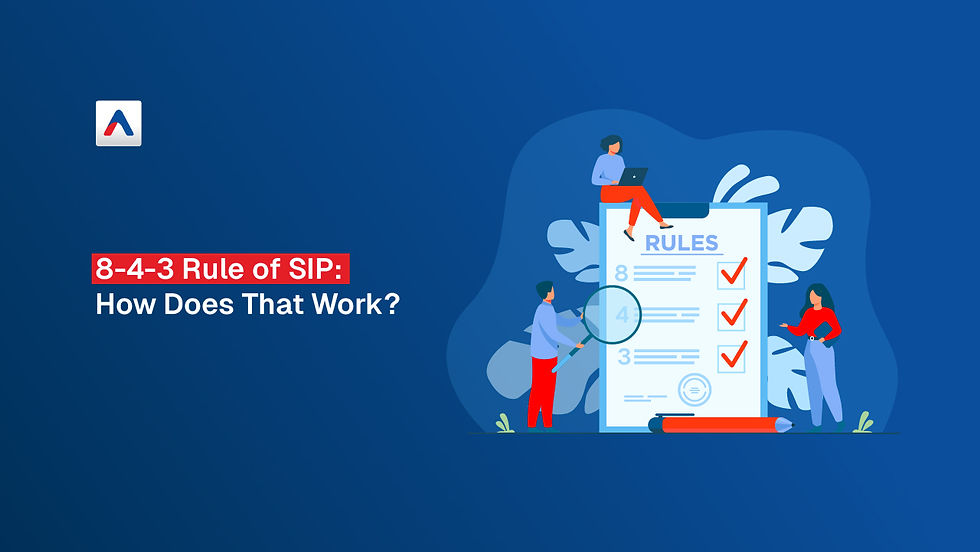8-4-3 Rule of SIP - How Does That Work?
- AssetPlus Editorial Team

- Jun 20
- 4 min read
Updated: Aug 6
Table of Content:
Introduction.
What is the 8-4-3 Rule of SIP ?
Phase 1: The First 8 Years – Building the Foundation.
Phase 2: The Next 4 Years – Acceleration.
Phase 3: The Final 3 Years – Exponential Growth.
Why the 8-4-3 Rule of SIP Works?
A Real-World Illustration.
Common Misconceptions.
Final Thoughts.

Introduction
The 8-4-3 Rule of SIP isn’t just a catchy phrase - it’s a powerful way to visualize how long-term investing and compounding work together to build wealth. Most investors start SIPs hoping to achieve big results, but many underestimate how returns accelerate in the later years.
This rule simplifies that journey by breaking it down into three distinct phases over 15 years: 8 years of consistent investing, followed by 4 years of growth momentum, and finally, 3 years of explosive compounding.
Let’s dive deeper into how 8-4-3 Rule of SIP works and what it teaches us about patience, timing, and smart investing.
What is the 8-4-3 Rule of SIP ?
The 8-4-3 Rule divides a 15-year SIP (Systematic Investment Plan) journey into three phases:
First 8 years: You consistently invest a fixed amount monthly.
Next 4 years: You continue investing and start seeing sharper growth due to accumulated returns.
Final 3 years: Your money experiences exponential growth as compounding fully kicks in.
It’s a mental model, not a rigid investment strategy. The idea is to help investors understand how wealth grows slowly at first, then faster, and then explosively as the years go by.
Phase 1: The First 8 Years – Building the Foundation
In the first 8 years of your SIP, the primary goal is accumulation. Your monthly contributions are building up a base corpus. During this phase, returns may feel modest, especially in volatile markets. However, this foundation is critical - it sets the stage for future returns to multiply.
For example, if you invest ₹10,000 per month at an assumed 12% annual return, you would contribute ₹9.6 lakh in total and see it grow to about ₹15.7 lakh by the end of Year 8.
Phase 2: The Next 4 Years – Acceleration
Between Year 9 and Year 12, your corpus begins to grow more rapidly. Why? Because the returns you earned during the first 8 years now start earning their own returns. This is the compounding engine gaining momentum.
Continuing with the same SIP of ₹10,000/month, your corpus could rise to around ₹30.8 lakh by the end of Year 12.
Phase 3: The Final 3 Years – Exponential Growth
Years 13 to 15 are when compounding hits full force. Even if your SIP amount doesn’t increase, the accumulated wealth starts generating substantial returns. In these 3 years, you may witness growth that matches or exceeds what was earned in the previous 4 years.
By the end of Year 15, your SIP could have grown to ₹47.6 lakh - all from a ₹18 lakh total investment.
Why the 8-4-3 Rule of SIP Works ?
This rule isn’t magic—it’s just the power of mathematics and time. The longer your money stays invested, the more time it has to compound.
Here’s why it works:
Time is the Biggest Multiplier: The early years allow your investment to grow slowly, but that growth sets the stage for exponential returns.
SIP Discipline: Investing consistently eliminates emotion and ensures contributions regardless of market swings.
Rupee Cost Averaging: By investing regularly, you buy more units when markets fall and fewer when they rise - averaging out your cost efficiently.
A Real-World Illustration
Let’s take a simple example assuming ₹10,000 SIP per month for 15 years at 12% CAGR. Here's how the investment grows over time:
Year | Total Invested (₹) | Corpus at Year-End (₹) | Growth in That Year (₹) |
1 | 1,20,000 | 1,26,827 | 6,827 |
2 | 2,40,000 | 2,72,998 | 1,46,171 |
3 | 3,60,000 | 4,34,556 | 1,61,558 |
4 | 4,80,000 | 6,12,623 | 1,78,067 |
5 | 6,00,000 | 8,08,423 | 1,95,800 |
6 | 7,20,000 | 10,23,280 | 2,14,857 |
7 | 8,40,000 | 12,58,621 | 2,35,341 |
8 | 9,60,000 | 15,15,986 | 2,57,365 |
9 | 10,80,000 | 17,97,046 | 2,81,060 |
10 | 12,00,000 | 21,03,602 | 3,06,556 |
11 | 13,20,000 | 24,37,595 | 3,33,993 |
12 | 14,40,000 | 28,01,111 | 3,63,516 |
13 | 15,60,000 | 31,96,389 | 3,95,278 |
14 | 16,80,000 | 36,25,831 | 4,29,442 |
15 | 18,00,000 | 40,91,024 | 4,65,193 |
Note: These are illustrative values based on consistent SIPs and 12% CAGR. Actual results may vary.
Look at how much growth comes in the final few years - it’s the clearest evidence of the compounding snowball in motion.
Disclaimer: Mutual Funds are subject to market risks. Please read all scheme related documents carefully.
Common Misconceptions
Let’s clear up a few myths:
It’s not a shortcut to stop investing after 4 years. The name refers to phases of growth, not an investing instruction.
Returns are not guaranteed. These are projections based on historical averages, not fixed outcomes.
It’s not a replacement for diversification or goal-based planning. Use this as a motivational framework, not a rigid formula.
Final Thoughts
The 8-4-3 Rule of SIP is not about doing less, but doing it right and doing it early. It reminds us that wealth doesn’t grow linearly - it grows slowly at first, then rapidly with time.
So, if you’re just starting out, remember:
Be early.
Be consistent.
Be patient.
That’s all it takes to build real wealth with SIPs.
Want to Begin Your SIP Journey?
Start with whatever amount you can, and let time do the heavy lifting. Need help setting it up? Talk to a mutual fund expert at AssetPlus today.


